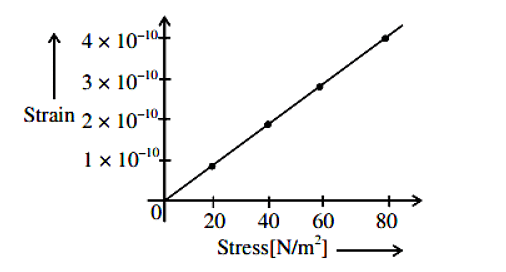Question:
How much should the pressure on a litre of water be changed to compress it by 0.10%? carry one quarter of the load.
How much should the pressure on a litre of water be changed to compress it by 0.10%? carry one quarter of the load.
Updated On: Oct 20, 2025
Hide Solution
Verified By Collegedunia
Solution and Explanation
Volume of water, \(V \)= \(1 \,L\)
It is given that water is to be compressed by \(0.10\) %.
\(\therefore\) Fractional change, \(\frac{\triangle V }{ V }\)
= \(\frac{0.1 }{ 100 \times 1}\) = \(10 - 3\)
Bulk modulus, \(B\) = \(\frac{p }{ \frac{\triangle V }{ V}}\)
\(P\) = \(B × \frac{\triangle V }{ V}\)
Bulk modulus of water, \(B\) = \(2.2 × 10^ 9 \,Nm^{ -2}\)
\(p\) = \(2.2 × 10^ 9 × 10^{ - 3}\)
= \(2.2 × 10^ 6 \,Nm^{ - 2}\)
Therefore, the pressure on water should be \(2.2 × 10^ 6 \,Nm^{ - 2}\).
Was this answer helpful?
1
0
Top Questions on elastic moduli
- The slope of the stress-strain curve in the elastic deformation region is
- JKCET - 2024
- Physics
- elastic moduli
- The law which states that within elastic limits strain produced is proportional to the stress producing it is known as
- JKCET - 2024
- Physics
- elastic moduli
- A wire of length L and radius r is clamped rigidly at one end. When the other end of the wire is pulled by a force F, its length increases by 5 cm. Another wire of the same material of length 4L and radius 4r is pulled by a force 4F under same conditions. The increase in length of this wire is ___ cm.
- JEE Main - 2022
- Physics
- elastic moduli
The elastic behavior of material for linear stress and linear strain, is shown in the figure. The energy density for a linear strain of 5×10–4 is ____ kJ/m3. Assume that material is elastic up to the linear strain of 5×10–4

- JEE Main - 2022
- Physics
- elastic moduli
- If the length of a wire is made double and radius is halved of its respective values. Then, the Young’s modulus of the material of the wire will :
- JEE Main - 2022
- Physics
- elastic moduli
View More Questions
Questions Asked in CBSE Class XI exam
- Discuss the shape of the following molecules using the VSEPR model:
BeCl2, BCl3, SiCl4, AsF5, H2S, PH3- CBSE Class XI
- The Valence Shell Electron Pair Repulsion (VSEPR) Theory
- What do you understand by isoelectronic species? Name a species that will be isoelectronic with each of the following atoms or ions.
- F-
- Ar
- Mg2+
- Rb+
- CBSE Class XI
- Electronic Configurations Of Elements And The Periodic Table
- Take one flower of the family Solanaceae and write its semi-technical description. Also draw their floral diagram.
- CBSE Class XI
- The Flower
- \(\text{tan x}=-\frac{4}{3},\text{x\, in\, quadrant \,II.}\)
- CBSE Class XI
- Trigonometric Functions of Sum and Difference of Two Angles
- Find \((x + 1)^6 - (x - 1)^6\). Hence or otherwise evaluate \((\sqrt2 + 1)^6 + (\sqrt2 - 1)^6.\)
- CBSE Class XI
- Binomial Theorem for Positive Integral Indices
View More Questions